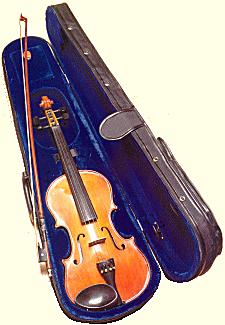| ||||||||

The Violin
The violin is a bowed, stringed musical instrument, the highest pitched member of the string instruments family. Among its prized characteristics are its singing tone and its potential to play rapid, brilliant figurations as well as lyrical melodies.
The violin has four stings tuned a fifth apart, to the notes g, d, a, e. These stings may be of gut, gut wound with aluminum or silver, steel or perlon. The bow used is a narrow stick about 30in long with a band of horsehair stretched from end to end of the bowstick. The player makes different pitches by placing the left-hand fingers on the string and pressing them against the fingerboard. The strings are then set in vibration and produce sound when the player draws a bow across them at a right angle. This beautiful instrument evolved from two medieval bowed instruments, the fiddle and the rebec. During the 17th century, it replaced the viol as the primary instrument in chamber music. Modification in the structure during the 18th and 19th century by the likes of Antonio Stradivari and Giuseppe Guarmeri led to a stronger, more robust and brilliant tone. The violin is probably the most well known and most widely distributed musical instrument in the world. This can be seen in the modern orchestra where the violins account for more than half of the players. In the predominant chamber music ensemble, the string quartet, consists of two violins, viola and cello. The violin achieved new artistic and technical heights in the hands of virtuosos such as Isaac Stern, Yehudi Menudin and Nicolo Paganini. Paganini improvised brilliantly and had flamboyant showmanship, which included trick effects such as severing one or two violin strings and continuing the piece on the remaining stings. Paul is a music lover from Singapore. His interests include classical music, musical instruments (especially the French horn) and HTML. He maintains both the French Horn Resource Page and the French Hornist Webring.
|
|




